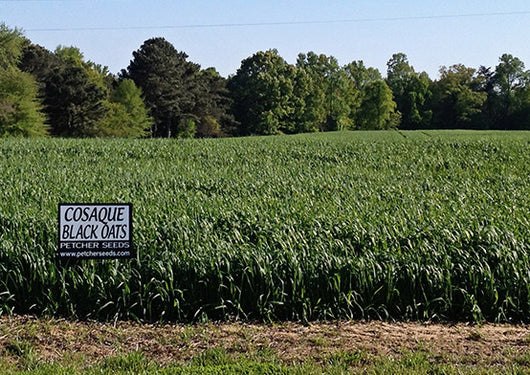
The cosaque oats are a black-seeded, Winter oat.
 Order Online or Call (251) 827-6594
Order Online or Call (251) 827-6594
Cosaque has higher biomass compared to cereal rye, ryegrass, wheat, triticale and other oats. It also offers excellent cold tolerance, great Winter weed suppression, good disease resistance, as well as nematode suppression. Cosaque has a fairly good C/N ratio, and a tremendous residue for next crop, which results in higher yields in the next crop. Cosaque has low lignin, making the plant very soft and palatable. It makes for excellent, nutrient-rich forage for grazing, hay, bay ledge, and silage. Wildlife loves it too.
Cosaque Oats prefers well-drained, sandy loam. Ideal pH is between 6.0 and 6.8. They can germinate at almost any soil temperature, but it will be worth your while to avoid the coldest, wettest days. The seed can be planted between late August and February. A depth of one inch is perfect. It will take 30 lbs. of Nitrogen at planting, and apply further Nitrogen, Phosphorus and Potash later based on a soil test. Cosaque establishes well and tillers very well also. It is typically two weeks longer in growing than other oat varieties.
John Coley (photographed below) from Montgomery, AL planted these black oats in early December. Seeding rate was 50 lbs. oats and 5 lbs. vetch, broadcast. He spread 2.5 tons of chicken litter and turbo tilled it in. The photo at the top of the page was taken in early May, just before planting this field into cotton. Coley, experienced with cover crops, comments “you get out of your cover crop what you put in it.” Rye has long been the standard in the South, however Cosaque may soon take the lead.

Here’s what you can expect when you plant Petcher Seeds’ Cosaque Oats.

Scientific Name:
Avena sativa

Seed Count:
12,000 seeds – 14,000 / LB.

Seasons:
Cosaque Oats are best planted from late August through February.

Planting Rate:
80 - 100 LBs. / acre for grazing


 Newsletter
Newsletter
 Contact
Contact
 My cart (0)
My cart (0)

















 Have a question?
Have a question?